Strike back: A 12-step guide after a lightning strike hits a wind turbine
Knowing what steps to take after a lightning strike hits wind turbines is crucial. This article explores the process of assessing and addressing damage post-lightning strike.

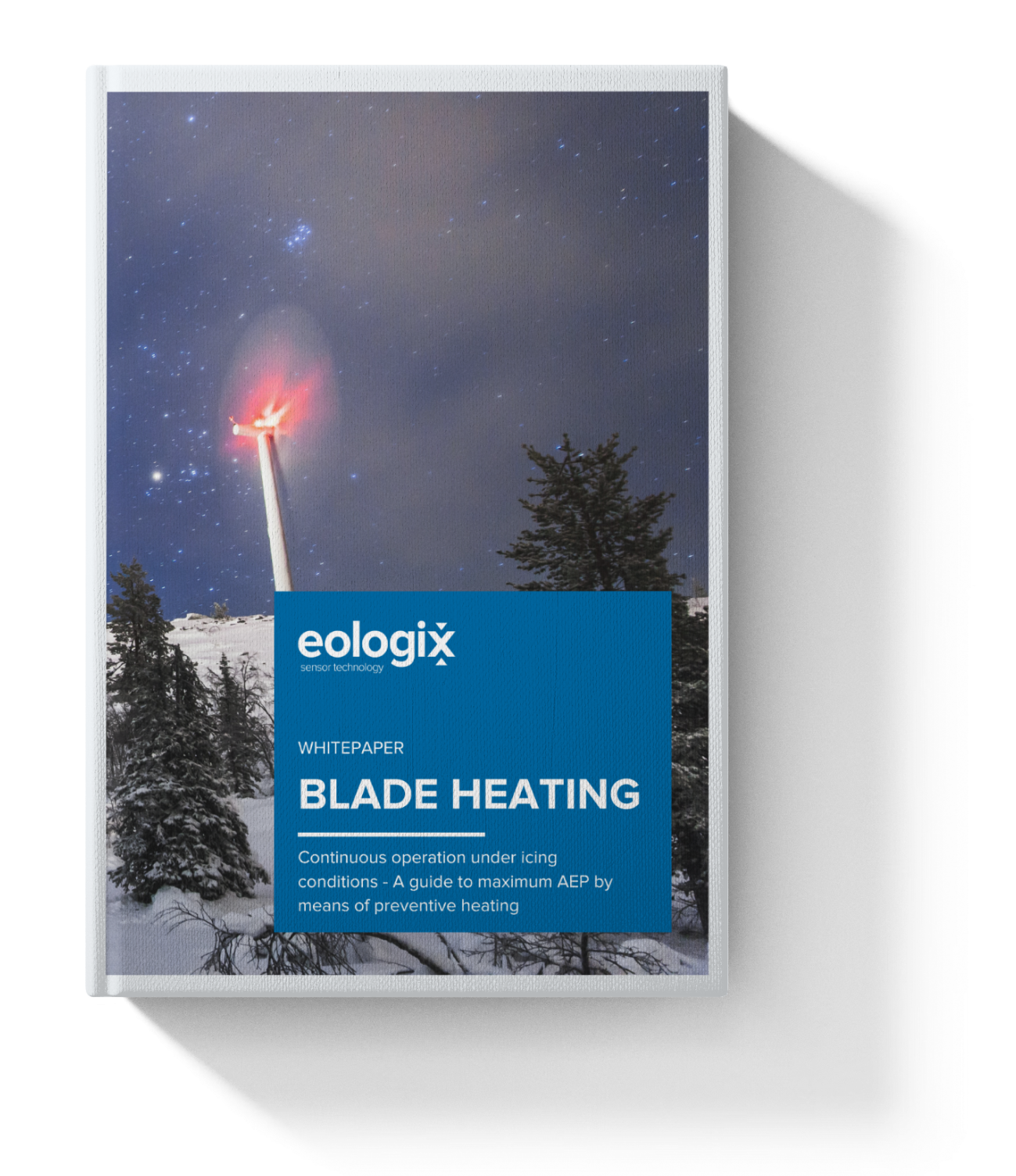



Welcome to the Blade heating Whitepaper. You’re about to start an exciting journey to transform your wind turbine performance.
Some of the most attractive wind resources in the world are located in cold climate
regions. These regions are on the one hand sparsely populated and have favourable
wind conditions, but on the other hand cold climate conditions with temperatures
down to -35°C subject wind turbines to tremendous challenges in operation and
maintenance.
What Will You Learn in This Whitepaper?
In this whitepaper you will find out why blade heating systems are needed, the different solutions for blade heating and how they differ and the importance of a suitable control strategy. One thing is certain: Precise ice detection and optimized blade heating means more yield for your wind turbine. We show you exactly how you can achieve this with your wind turbine in our whitepaper. Therefore, we summarise all the information needed, so that you can get a clear picture.
Yes, it can be also informative for you, if you have losses due to icing, as we also show different retrofittable solutions.
Complete the form and after that check your inbox. You have to confirm your email address to receive our free whitepaper about blade heating.
We will always keep your personal information safe.
We ask for your information in exchange for a valuable resource in order to improve your browsing experience by personalizing the eologix site to your needs, to send information to you that we think may be of interest to you by email or other means and to send you marketing communications that we think may be of value to you. You can read more about that in our privacy policy.
© eologix sensor technology gmbh 2022
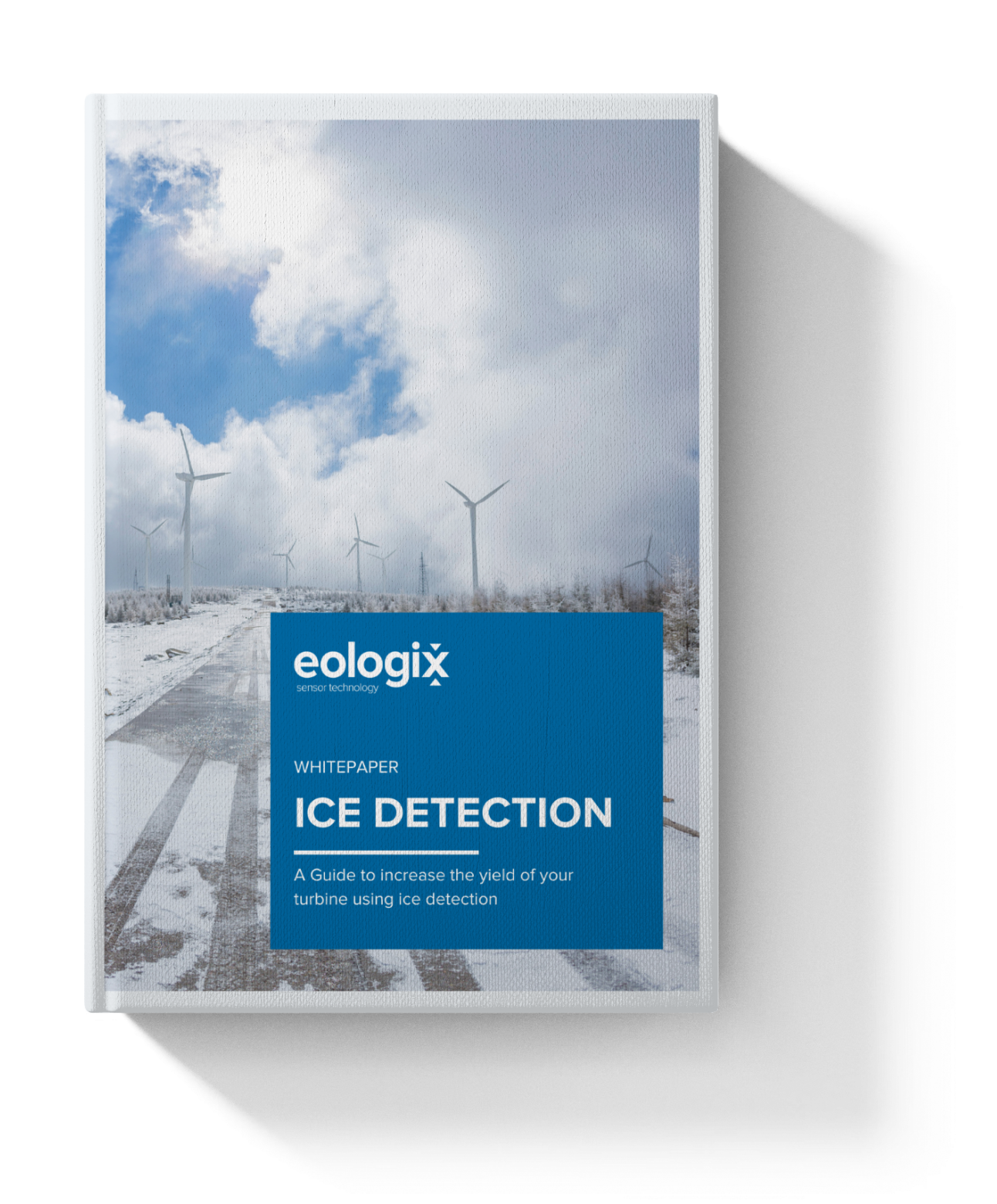



Welcome to the Ice Detection Whitepaper. You’re about to start an exciting journey to transform your wind turbine performance.
Ice formation on wind turbines has a relevant influence on operational management in the cold season. In addition to reduced yield due to changed aerodynamic properties, the safety of the system and its surroundings is a key issue.
What Will You Learn in This Whitepaper?
In this whitepaper you will find out why precise ice detection is relevant, the different solutions for ice detection and how they differ and the benefits by using an ice detection system. One thing is certain: Precise ice detection and temperature measurement means more yield for your wind turbine. We show you exactly how you can achieve this with your wind turbine in our whitepaper. Therefore, we summarise the results of some relevant studies so that you can get a clear picture.
Yes, absolutely. Even with few icing events a safety-relevant icing can occur.
Complete the form and after that check your inbox. You have to confirm your email address to receive our free whitepaper about ice detection.
We will always keep your personal information safe.
We ask for your information in exchange for a valuable resource in order to improve your browsing experience by personalizing the eologix site to your needs, to send information to you that we think may be of interest to you by email or other means and to send you marketing communications that we think may be of value to you. You can read more about that in our privacy policy.
© eologix sensor technology gmbh 2022
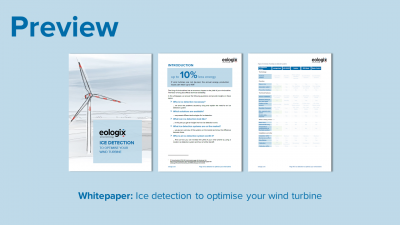
Ice formation on wind turbines has a relevant influence on operational management in the cold season. In addition to reduced yield due to changed aerodynamic properties, the safety of the system and its surroundings is a key issue.
In this whitepaper you will find out why precise ice detection is relevant, the different solutions for ice detection and how they differ and the benefits by using an ice detection system.
One thing is certain: Precise ice detection and temperature measurement means more yield for your wind turbine..
We show you exactly how you can achieve this with your wind turbine in our whitepaper. Therefore, we summarise the results of some relevant studies so that you can get a clear picture.
Simply download the free whitepaper (21 pages)
… we show the problems caused by icing and explain the need for an ice detection system
… we present different technologies for ice detection
… find out how you can increase the yield of your wind turbine by using a modern ice detection
system and how to further benefit
Complete the form and get our free whitepaper about ice detection.
TECHNOLOGY | 7 MIN TO READ
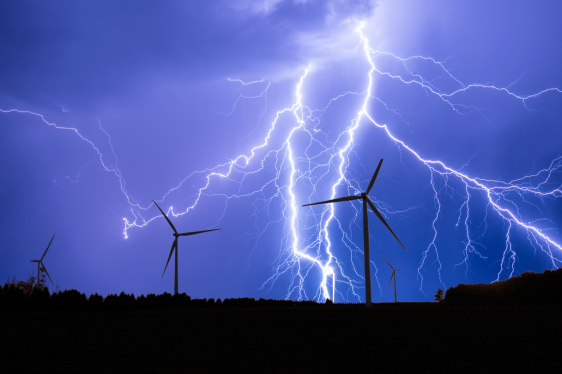
Wind energy has emerged as a pivotal player in the global transition towards sustainable power sources. As wind turbines stand tall and harness the power of the wind, they are not without their challenges. One significant challenge that engineers and operators grapple with is the impact of lightning strikes on these towering structures.
Lightning strikes bring a unique set of challenges for wind turbine operators. The intense heat generated during a strike can compromise the structural integrity of various components. From blades to towers, being vigilant about potential damage is crucial for ensuring the safety and longevity of the turbines.
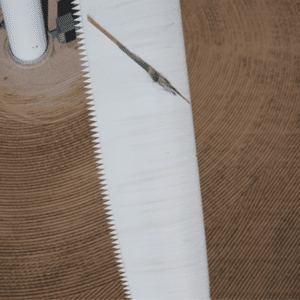
Beyond the immediate effects of a lightning strike, operators need to be aware of a subtler adversary – blade erosion. The heat from lightning can cause erosion and pitting on the turbine blades, affecting their aerodynamic efficiency over time. Regular inspections become a frontline defense to spot and address this silent challenge.
The intricate electrical systems that power wind turbines are susceptible to the impact of lightning. High currents and voltages can damage critical components, leading to potential malfunctions. For operators, understanding the vulnerability of these systems is key to minimizing downtime and maintenance costs.
With the combination of lightning’s heat and turbine materials, operators must be attuned to the risk of fires. Establishing robust emergency response protocols is not just a safety measure for the turbine but also for the surrounding areas. Swift action can make a significant difference in minimizing damage and ensuring the safety of both equipment and personnel.
Operators know that downtime is the enemy of productivity. Lightning-induced damage means not just repairs but also a potential dip in energy production. Efficient planning and proactive maintenance strategies are vital for minimizing downtime and keeping the turbines operational.
What can be done to minimise the risks of lightning strikes on wind turbines? There are various possibilities – we present three strategies below: monitoring tools and early detection, investing in lightning protection systems and adapting environmental practices.
In the world of wind turbine operation, knowledge is power. Implementing effective monitoring and detection tools can provide operators with early insights into potential lightning strikes. Early detection allows for timely assessments and proactive interventions, helping to keep turbines operational and reducing the overall impact (i.e. Lightning detection system).
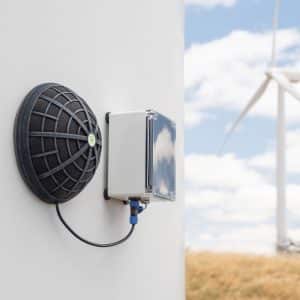
For operators, investing in reliable Lightning Protection Systems (LPS) is a strategic move. These systems, including lightning rods and grounding solutions, act as a shield against the impact of lightning strikes. Well-designed LPS not only protect the turbines but also contribute to overall operational reliability.
Wind turbine operators often find themselves in ecologically sensitive areas. Understanding the environmental implications of lightning strikes, especially the risk of fires, underscores the importance of responsible and sustainable practices. Balancing energy production with environmental considerations is a delicate but necessary task.
As wind turbine operators navigate the complexities of their role, understanding and addressing the challenges posed by lightning strikes is essential. By embracing proactive maintenance, investing in monitoring technologies, and implementing robust Lightning Protection Systems, operators can not only weather the storm but also ensure that the turbines they oversee continue to generate clean, sustainable energy for years to come.
Knowing what steps to take after a lightning strike hits wind turbines is crucial. This article explores the process of assessing and addressing damage post-lightning strike.
Recent data offers cruical insights into lightning activity across the United States. In this blog, we delve deeper into lighting prone areas in the US and summarized the most important data for you.
Wind energy has emerged as a pivotal player in the global transition towards sustainable power sources. As wind turbines stand tall and harness the power of the wind, they are not without their challenges. Let’s delve into the challenges and potential consequences of lightning strikes on wind turbines.
Wind turbines are exposed to various environmental influences all over the year – with sometimes considerable effects on performance, yield and safety. Icing also plays a major role here. Innovative blade heating systems therefore offer various approaches to solving the icing problem and protecting the environment and your service team.
To ensure efficient and reliable power generation from wind turbines, they must be regularly maintained and inspected to identify and rectify potential problems such as imbalances. There are basically two types of imbalance that can occur in wind turbines: mass imbalance and aerodynamic imbalance.
How do acceleration and pitch angle interrelate? How can pitch angles be measured effectively and deviations detected?
TECHNOLOGY | 9 MIN TO READ
Are your turbines affected by icing?
Find out more about this topic in our whitepaper on blade heating.
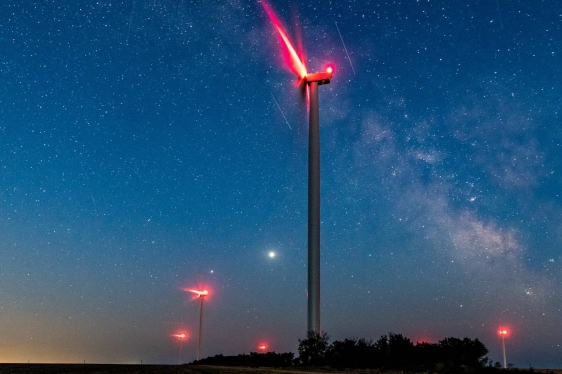
There are two main solutions for rotor blade heating established by wind turbine manufacturers (OEMs) on the market:
With this method, a heater-fan unit creates an air flow in specific channels in the rotor blade. The hot air passes by the leading edge, warms up the shell material to the blade surface above 0 °C and allows to thaw the ice layer. The same device can also be used as a de-icing system.
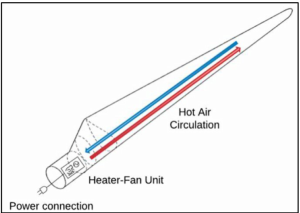
This method uses electro-thermal heating elements, which are embedded inside the rotor blade or laminated in the blade surface layer. This technology not only allows continuous operation, but also effectively prevents ice accumulation.
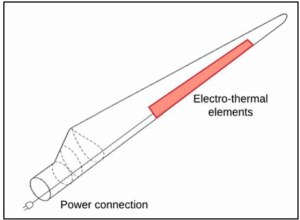
The operating strategy of the rotor blade heating plays a key role in both systems. This should be taken into account to optimize efficiency, reduce heating costs and prevent overheating and damages due to overheating.
Different OEMs* have developed different approaches to rotor blade heating to meet specific requirements.
Enercon’s technology combines an ice detection system with hot air circulation inside the rotor blades for efficient de-icing. The duration of the de-icing process depends on the ambient temperature and wind speed. As soon as the process is complete, the turbine can be restarted with ice-free rotor blades. At sites with minimal icing risk, the system allows de-icing to be carried out while the turbine remains running.
Key design features**
The Nordex system consists of an ice sensor and electrothermal heating mats (underneath the blade surface) at the leading edge of each rotor blade. The sensors continuously monitor ambient conditions and report the status to the wind turbine’s operational management system.
If icing conditions appear, the system offers two different options:
Siemens Gamesa relies on a blade heating system** with an ice detection system, blade heating elements (integrated into the blade surface at the OEM) and a system to control the de-icing strategy.
Siemens Wind Power De-icing Strategy
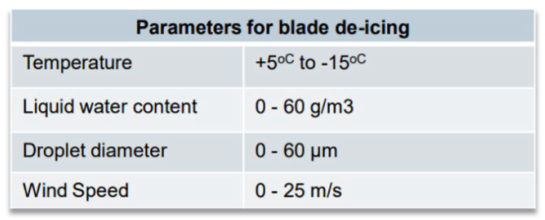
Vestas offers various solutions for sites with cold climates. The Vestas Anti-Icing System™ combines several independent heating elements and levels, which – according to Vestas – enable anti-icing measures tailored to the respective icing event.
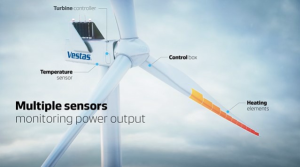
In addition to manufacturer solutions, there are various providers who offer retrofittable solutions. You can find more details in our white paper on blade heating.
Source (if there is no link in the text):
**Charles Godreau (2022): Tackling Icing on Wind Turbines with Ice Protection Systems, Current State -of-the-Art and Future Research, NERGICA, IGW Wind Industry Stakeholder Meeting
*** Will heat be the winner in de-icing turbine blades? | Reuters Events | Renewables. (o. D.). Abgerufen am 20. Oktober 2022, von https://www.reutersevents.com/renewables/wind-energy-update/will-heat-be-winner-de-icing-turbine-blades & Siemens Gamesa. (o. D.). Onshore technological solutions. Abgerufen am 17. September 2022, von https://www.siemensgamesa.com/en-int/-/media/siemensgamesa/downloads/en/products-and-services/onshore/brochures/siemens-gamesa-onshore-tech-solutions-en.pdf
Knowing what steps to take after a lightning strike hits wind turbines is crucial. This article explores the process of assessing and addressing damage post-lightning strike.
Recent data offers cruical insights into lightning activity across the United States. In this blog, we delve deeper into lighting prone areas in the US and summarized the most important data for you.
Wind energy has emerged as a pivotal player in the global transition towards sustainable power sources. As wind turbines stand tall and harness the power of the wind, they are not without their challenges. Let’s delve into the challenges and potential consequences of lightning strikes on wind turbines.
Wind turbines are exposed to various environmental influences all over the year – with sometimes considerable effects on performance, yield and safety. Icing also plays a major role here. Innovative blade heating systems therefore offer various approaches to solving the icing problem and protecting the environment and your service team.
To ensure efficient and reliable power generation from wind turbines, they must be regularly maintained and inspected to identify and rectify potential problems such as imbalances. There are basically two types of imbalance that can occur in wind turbines: mass imbalance and aerodynamic imbalance.
How do acceleration and pitch angle interrelate? How can pitch angles be measured effectively and deviations detected?
TECHNOLOGY | 9 MIN TO READ
Would you like to know more details? Have a look at our whitepaper about ice detection and get to know every interesting detail.
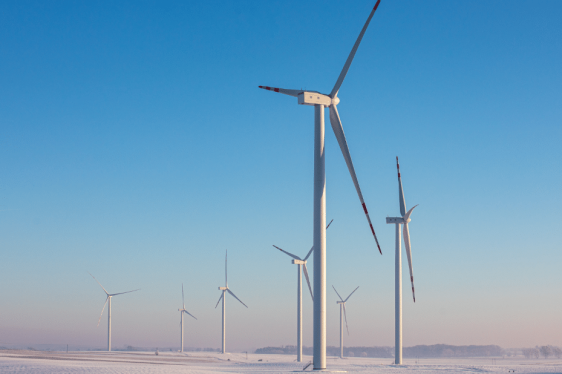
In winter, especially in northern regions or colder regions (so-called cool climate regions), wind turbines are exposed to snow, ice and frost. Icing can significantly impair the performance of wind turbines. Intelligent de-icing systems minimize downtimes and thus yield losses.
Anti-icing systems can be divided into two main categories: Anti-icing systems (anti-icing systems) and De-icing systems (de-icing systems). Anti-icing systems prevent ice from accumulating on the rotor blades, while de-icing systems remove an existing layer of ice from the rotor blade surface.
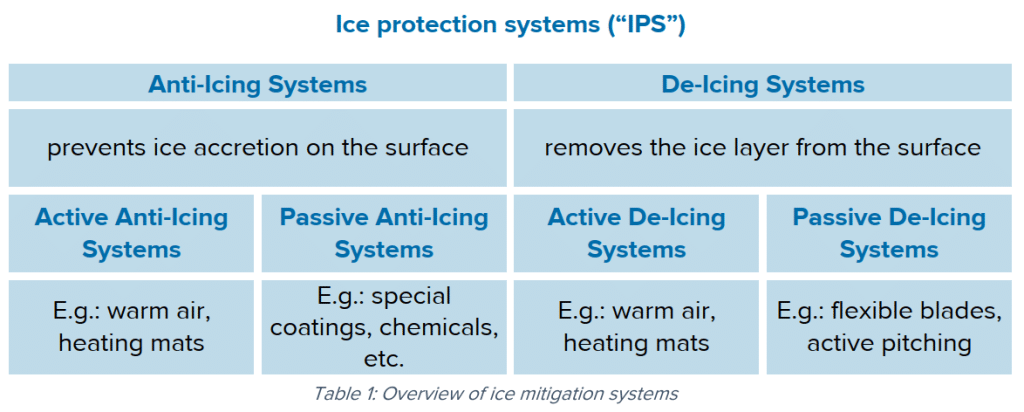
Anti-icing systems are those that protect the wind turbine from icing. Specifically, this means that anti-icing systems prevent the formation of ice on the rotor blade surface. These systems can be divided into active systems, such as electronic heating elements in the rotor blades or hot air heating, and passive systems, such as special coatings, black paint or chemicals.
In contrast to de-icing systems, wind turbines can remain in operation as ice formation on the rotor blade surface is prevented.
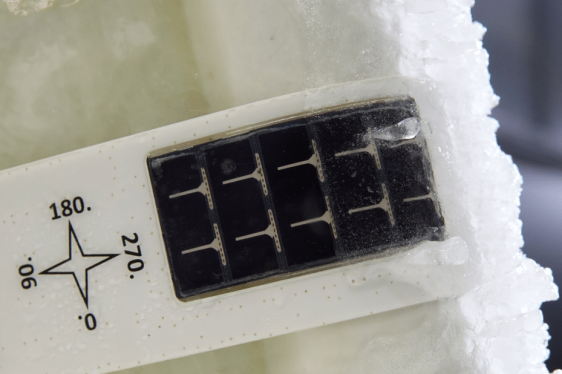
De-icing systems are de-icing systems that remove an existing layer of ice that has formed on the rotor blades. They can also be divided into active systems, such as electronic heating elements in the rotor blades or hot air heating, and passive systems. However, the system must be stopped either manually or automatically for de-icing. Once the rotor blades have been checked and classified as ice-free, the affected wind turbines can be put back into operation.
Whether an active ice protection system is used as an anti-icing or de-icing system depends largely on the heating control strategy used, which in turn depends on various operational constraints, such as the permission for turbines to rotate with ice on the blades, operating restrictions for wind turbines, etc.
Read more about different heating control strategies in our whitepaper – Blade heating.Whitepaper Blade Heating
Wind turbines are designed to operate for 20 to sometimes even 30 years. During this time, they should deliver the maximum energy yield reliably and with the highest possible technical availability.
However, icing can significantly impair the performance of wind turbines in many respects. These include
You can find more information on the risk factor of icing in our blog article Dangers and risks due to ice formation on wind turbines.
The need for blade heating depends on various factors, such as location, weather conditions and turbine size. A good indicator is the loss of revenue (i.e. how much of the annual energy yield is lost due to icing of the rotor blades and the associated downtimes).
As a rule of thumb, the following losses justify the integration of a blade heating system:
In order to optimize the performance of a wind turbine, it is crucial to detect icing at an early stage and react with appropriate measures. Continuous monitoring of the rotor blades, whether with or without automatic restart, can be a decisive factor here. Ensure that your system is protected against icing in good time.
Knowing what steps to take after a lightning strike hits wind turbines is crucial. This article explores the process of assessing and addressing damage post-lightning strike.
Recent data offers cruical insights into lightning activity across the United States. In this blog, we delve deeper into lighting prone areas in the US and summarized the most important data for you.
Wind energy has emerged as a pivotal player in the global transition towards sustainable power sources. As wind turbines stand tall and harness the power of the wind, they are not without their challenges. Let’s delve into the challenges and potential consequences of lightning strikes on wind turbines.
Wind turbines are exposed to various environmental influences all over the year – with sometimes considerable effects on performance, yield and safety. Icing also plays a major role here. Innovative blade heating systems therefore offer various approaches to solving the icing problem and protecting the environment and your service team.
To ensure efficient and reliable power generation from wind turbines, they must be regularly maintained and inspected to identify and rectify potential problems such as imbalances. There are basically two types of imbalance that can occur in wind turbines: mass imbalance and aerodynamic imbalance.
How do acceleration and pitch angle interrelate? How can pitch angles be measured effectively and deviations detected?
Misalignments of the rotor blade can result in imbalances, with considerable effects on the performance of your wind turbine. Continuous measurement of pitch angles with the on-blade sensor system enables you to
Our system for pitch angle measurement is
“Almost 80% of all wind turbines have an unacceptable rotor imbalance and/or pitch angle error.”
(WiD Whitepaper Balancing of wind turbines rotors: Economic advantages and technical implementation written from Dr. Christoph Heilmann, Anke Grunwald, Michael Melsheimer, Berlinwind GmbH)
Wireless and flexible smart sensors are powered by solar energy almost indefinitely. Each sensor measures the accelerations that occur at the sensors during operation of the wind turbine. From these accelerations, we can infer the rotational speed of the rotor and the alignment of these blades.
Due to the unique, patented design (flexible, less than 2 mm thick), the sensors can be mounted on almost any part of the rotor blade, but also on other structures, such as nacelle or tower. The mounting is done by means of self-adhesive erosion protection foil.
The base station (one unit per installation) receives the data packages sent out by the sensors via radio. It is typically installed as a component in the nacelle, but can also be mounted in the spinner, in the tower base or on the ground.
In our online dashboard, both live and historical data can be viewed and exported.
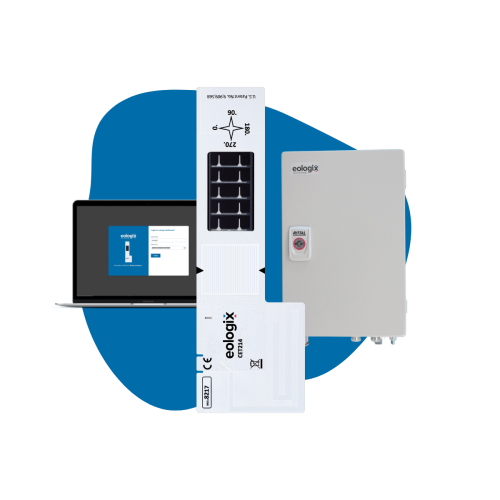
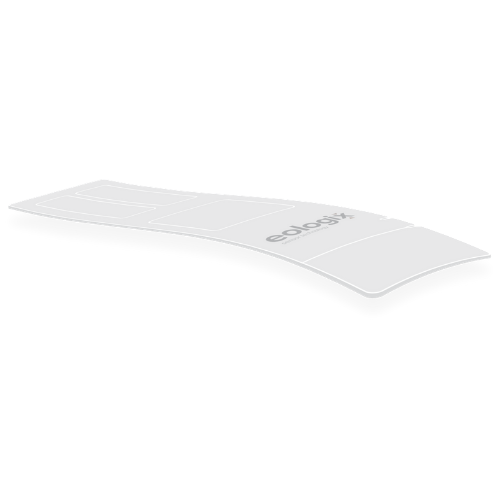
With this product, the relative pitch angles are continuously measured during operation of the system. The system automatically warns* in case of deviations outside the limit values.
*Automatic warning message only included in the package eologix:align Advanced
In contrast to ground-based systems, the on-blade system detects relative pitch angle errors at an early stage through continuous monitoring and provides an automatic warning message. The on-blade system can be used at any location (including forest, offshore, etc.) as well as on any wind turbine and also offers the possibility of correlation with turbine data (including evaluation of pitch via rotor speed).
On blade-pitch angle monitoring:
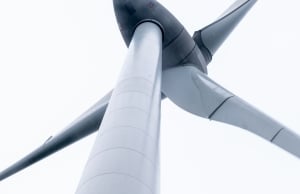
TECHNOLOGY | 7 MIN TO READ
Whitepaper: Optimise your wind turbine by using ice detection
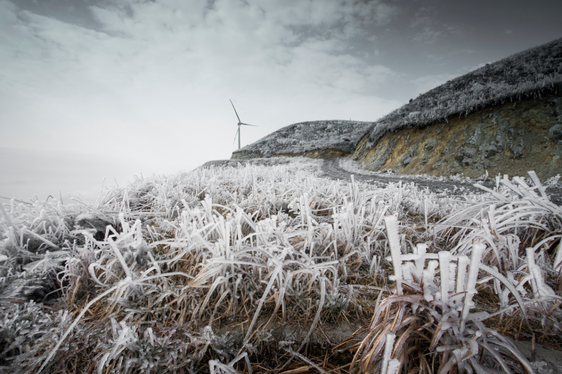
Cost efficiency, high yields and turbine safety are the most important factors in the operation of wind turbines. Ice detection systems provide support to ensure efficient operation of wind turbines even in the windiest winter months.
As part of a project (Meteotest (2021), Comparison of four detection systems of rotor icing installed on the same turbine, VGB Research Foundation, Project 401), a comprehensive field test was conducted from 2016-2020 in Stor-Rotliden, Sweden. The aim was to install all four established blade-based ice detection systems (IDS) from Polytech (former fos4x), Wölfel, Weidmüller and eologix on the same Vestas V-90 and comparing them over many icing events (none of the four IDS controls the WT during the field test).
Efficient operation of wind turbines under icing conditions requires accurate detection of icing, both in terms of timing and severity. The four different IDS detect rotor icing from the inside or outside of the rotor blades:
eologix – www.eologix.com
eologix offers (retrofittable) sensor systems for early and exact ice detection based on the electrical impedance directly on the rotor blade surface. The sensors are wireless, flexible, smart and energy-self-sufficient and installed directly on the surface of rotor blades.
Polytech (ehemals fos4x) – www.polytech.com
The system measures and learns the natural frequencies of the rotor blades under various operating conditions. As soon as ice masses form on the blades, the vibration behavior of the rotor blades changes. Measuring accuracy of less than 9 mm or less than 10 kg per blade.
Weidmüller – www.weidmueller.de
BLADEcontrol® measures the degree of icing directly on the rotor blades and is based on a simple physical principle: The ice accumulation changes the natural vibration behavior of the rotor blade due to its additional weight, which reduces the vibration frequency.
Wölfel – www.woelfel.de
IDD.Blade measures the vibration behavior with sensors inside the rotor blades. If the mass of a rotor blade changes due to ice accumulation, the vibration behavior also changes.
Read more about the differences between rotor blade-based ice detection systems in our Whitepaper Ice Detection.
After four winter seasons a data set of approximately 5700 operating hours (simultaneous operation of all four systems) of the wind turbines was collected, with approximately 2500 hours of icing (only rime ice). Several cameras have been used as a reference. This unique dataset allows a detailed comparison of the four blade-based IDS.
The analysis of the icing events showed that there is a consistensy between all four IDS and the camera images in terms of the timing of the icing events. The number of icing events for the three vibration-based IDS is very similar. However, differences in the total duration of turbine stops could be observed due to different sensitivity of the systems. Concerning the eologix system, there were significantly fewer and shorter downtimes.
The following figure shows an example of an ice event from this study. As can be seen in the figure, the eologix sensor system is the first to detect ice (turquoise – showing the eologix sensors), whereas the vibration-based ice detection systems (IDS1, IDS2 and IDS3) detect ice much later (visible in red).
The eologix system is the last system to shut down the plant, as it can distinguish between safety-relevant icing and non-safety-relevant icing (shown in red in the eologix line above| compared to IDS1, IDS2 and IDS3).
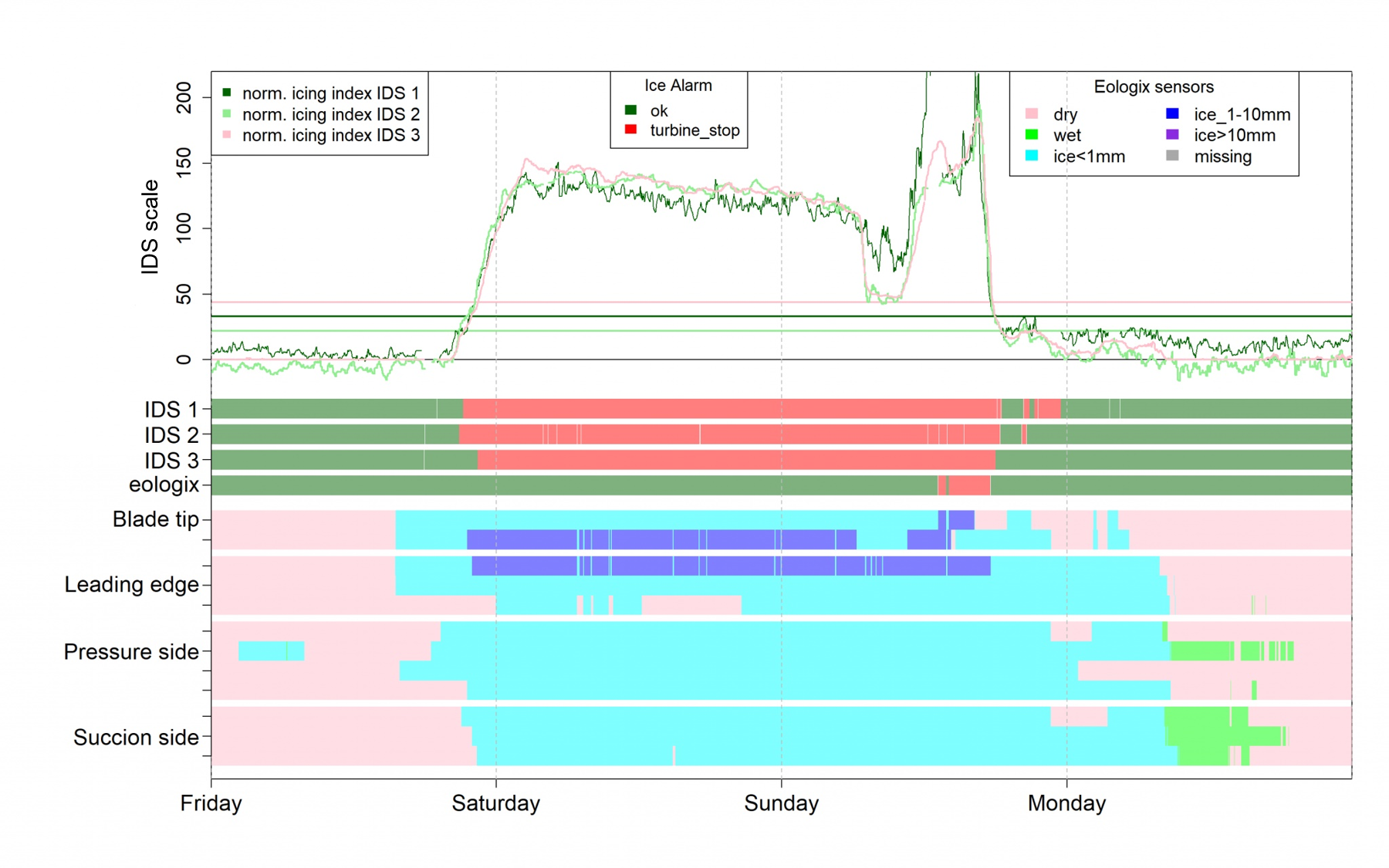
Example of an ice event (VGB research project 401; Abstract presented at Winterwind 2021) – (Source: Comparison of four blade-based ice detection systems installed on the same turbine, Paul Froidevaux, Meteotest AG, Winterwind 2021, April 20, 2021)
“[…] most sensitive ice detection status from all four systems.”
(Quote about the eologix system (Meteotest (2021), Comparison of four detection systems of rotor icing installed on the same turbine, VGB Research Foundation, project 401)
Regarding the eologix ice detection system the following points were summarized as results:
It was further noted, unlike the eologix system, the three vibration-based systems could not detect icing at low wind speeds or in the case of standstill.
Knowing what steps to take after a lightning strike hits wind turbines is crucial. This article explores the process of assessing and addressing damage post-lightning strike.
Recent data offers cruical insights into lightning activity across the United States. In this blog, we delve deeper into lighting prone areas in the US and summarized the most important data for you.
Wind energy has emerged as a pivotal player in the global transition towards sustainable power sources. As wind turbines stand tall and harness the power of the wind, they are not without their challenges. Let’s delve into the challenges and potential consequences of lightning strikes on wind turbines.
Wind turbines are exposed to various environmental influences all over the year – with sometimes considerable effects on performance, yield and safety. Icing also plays a major role here. Innovative blade heating systems therefore offer various approaches to solving the icing problem and protecting the environment and your service team.
To ensure efficient and reliable power generation from wind turbines, they must be regularly maintained and inspected to identify and rectify potential problems such as imbalances. There are basically two types of imbalance that can occur in wind turbines: mass imbalance and aerodynamic imbalance.
How do acceleration and pitch angle interrelate? How can pitch angles be measured effectively and deviations detected?
Our sensors are installed all along the blade surface up to the tip (incl. leading edge), directly detecting icing and measuring the surface temperature.
*according to Meteotest (2021), Comparison of four detection systems of rotor icing installed on the same turbine, VGB Research Foundation, project 401
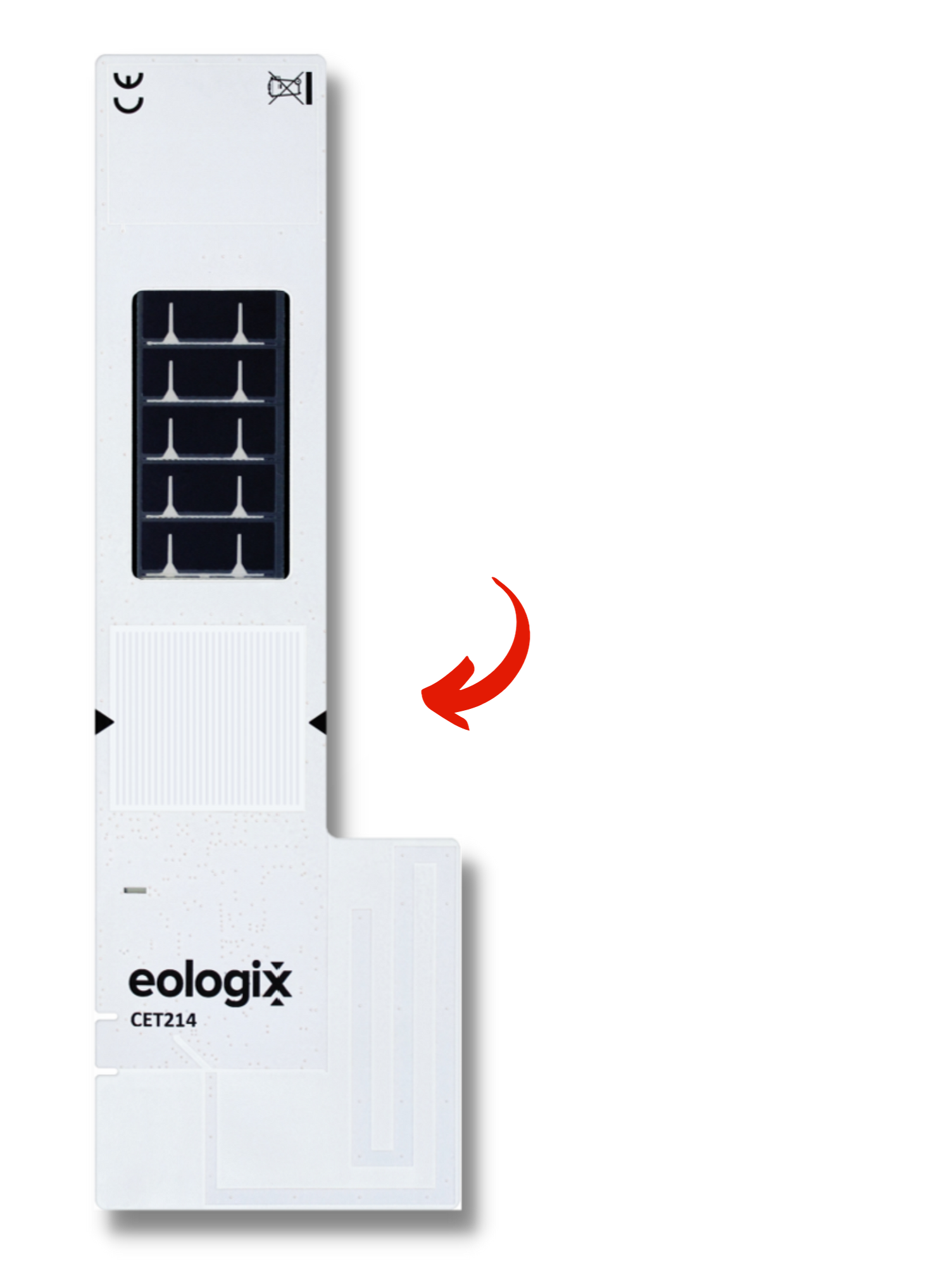
eologix offers (retrofittable) sensor systems for early and exact detection of ice accumulation and pitch misalignment based on wireless, flexible, smart and energy-self-sufficient sensors installed directly on the surface of rotor blades

Example of an ice event (VGB research project 401; Excerpt presented at Winterwind 2021) – Public report to be published soon (Source: Comparison of four blade-based ice detection systems installed on the same turbine, Paul Froidevaux, Meteotest AG, Winterwind 2021, April 20, 2021)
*according to Meteotest (2021), Comparison of four detection systems of rotor icing installed on the same turbine, VGB Research Foundation, project 401
“The eologix system is uncomplicated and easy to install. The technology is simple but of good quality and does a very good job. The system reacts quickly and very precisely. An additional positive effect was the good project cooperation with eologix the support was very good.“
“We have chosen the eologix sensor system because it measures directly on the rotor blade and therefore ice detection is faster and more accurate than with other comparable systems.“
“Technically, it is an exciting product, as eologix is the only supplier that measures directly on the blade surface and can thus determine the icing condition. The more accurate and sensitive the ice detection system is, the higher the optimization potential of the individual plants is.”
“[…] eologix would have stopped the turbine approximately 2.5 times less than the VBS.” (Vibration-Based Systems)
“[…] the eologix system was most often the first IDS to detect the presence of light icing, it would have been the last to stop the turbine.”

“The eologix system works perfectly and provides the best information about the condition of the blade in case of ice formation. When it comes to which system is reliable, I would definitely fully recommend the eologix system – I would choose time and again the eologix solution.”
“In short: we are very satisfied with eologix.”

“Each company has to decide for itself whether to measure based on vibrations or directly on the rotor blade surface. However, it is nice that eologix carries out a precise measurement and also measures the thickness of the ice layer accurately.“








So here’s what you can do now to get started:
Not ready for a demo yet? Check out our Whitepaper Ice detection for more information.


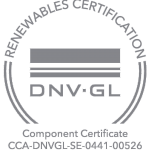
TECHNOLOGY | 5 MIN TO READ
You can find out how icing occurs, which phases of icing there are and what it actually depends on in our white paper: Optimize your turbine with the help of ice detection
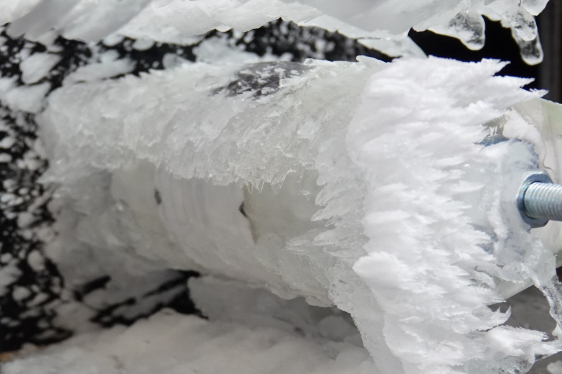
Hoarfrost is a form of fog-frost deposition, usually thin, fragile ice needles or scales that adhere only loosely to objects and are formed almost exclusively by sublimation. The prerequisites for the formation of frost are high humidity (around 90 % or more), weak wind and temperature values generally below minus 8 °C.
RIme ice is a solid precipitation that forms mainly at high wind speeds and an air temperature of typically -2 to -10 degrees Celcius. This ice forms from supercooled fog water droplets and forms on surfaces, typically against the wind direction. The formed ice layer of grey-white granular particles have a sponge-like appearance and are quite loose compared to solid glaze ice.
Rime ice is characterised by the fact that it has no crystalline structures and includes a large number of air bubbles in its structure. The partial melting and refreezing of the particles causes them to stick together to varying degrees, depending on the prevailing temperature conditions.
Smooth, compact, transparent and very firmly adhering ice deposit of indeterminate shape and irregular surface. Glaze ice is formed at air temperatures between 0 and minus 3 °C by slow freezing of supercooled mist droplets on objects. Glaze ice can grow into extremely heavy ice loads.
high humidity (>90%)
below -8°C
light wind
typ. -2 to -10°C
especially at high wind speeds
between 0 and -3°C
clear, transparent, solid
Before 1986, “Raureif” was the collective term used at the “Deutscher Wetterdienst” for glaze ice, rime ice and frost.
In principle, all three types of icing, namely hoarfrost, rime ice and glaze ice can occur on rotor blades.
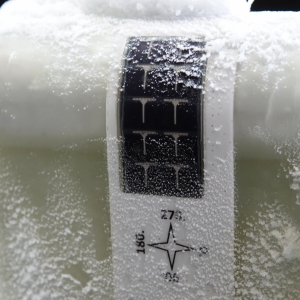
In low-lying countries, ice layers are usually very thin and light and therefore do not represent any danger. At high altitudes, however, wind turbines are operated within the cloud cover, so that layers of rime ice can very often become very dense and hard and can be 10 cm or more thick at the leading edge of the rotor blades. Such deposits of rime ice pose a danger during operation of the wind turbine.
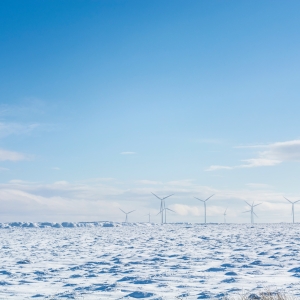
Only poses a safety hazard from a very high density (several cm). Due to its low density and large surface area, it detaches from the rotor blades like snowfall.
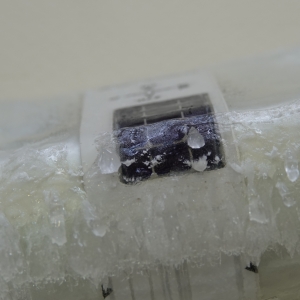
Due to the very high density and the possible layer thickness of several centimetres, ice accumulations in the form of glaze ice pose a danger during operation of the wind turbine.
Dropped ice fragments from iced rotor blades have already been found at a distance of more than 100m from wind turbines. Therefore, appropriate safety measures must be taken against ice throw and ice fall.
Ice accumulation on rotor blades represents a potential risk for the operation of a wind turbine
eologix sensors in use in the Climate Wind Tunnel at the FH Joanneum
The best way to make good decisions is to base them on solid knowledge. That’s why our products undergo a wide range of tests before we introduce them to the market.
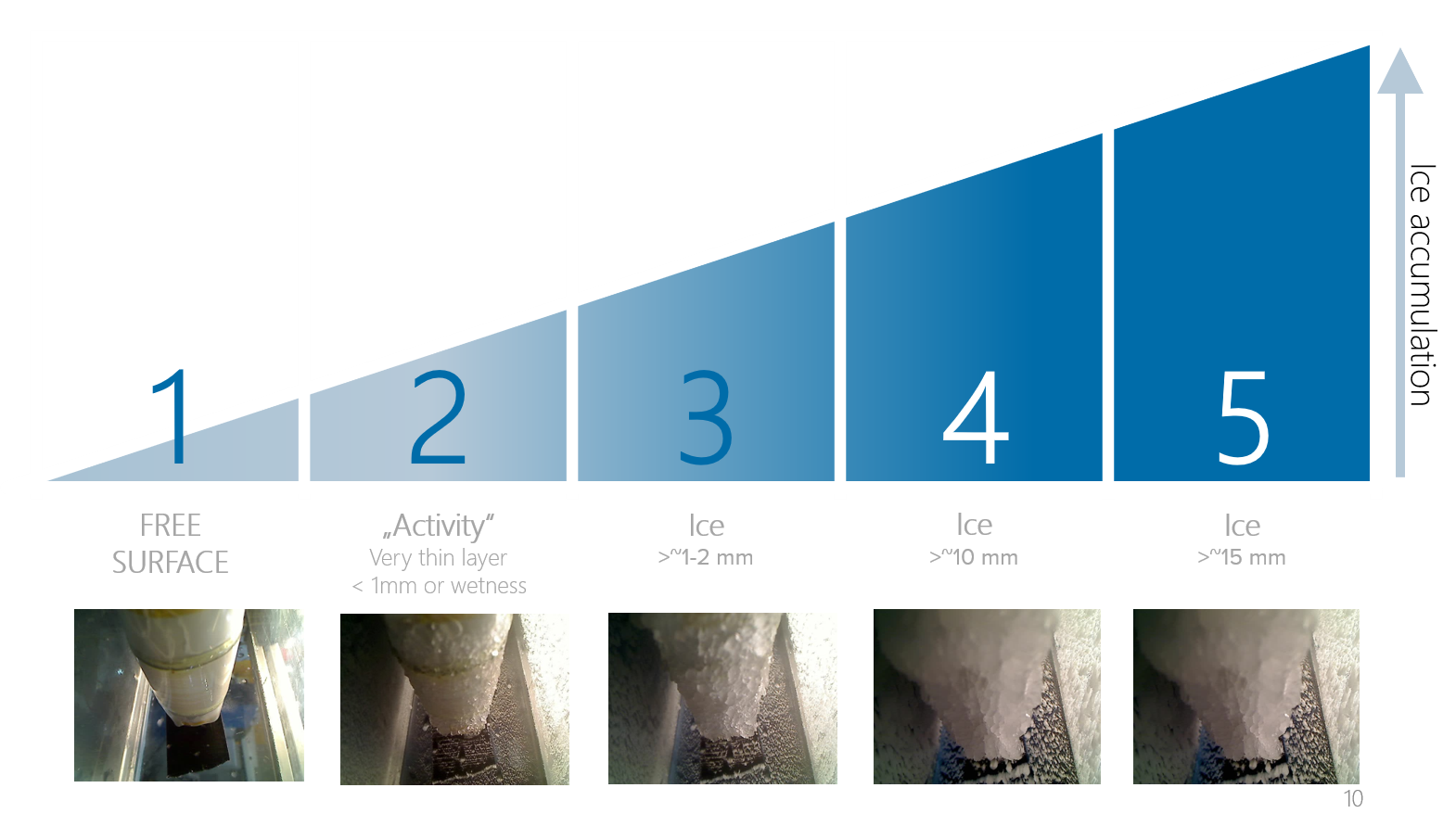
Knowing what steps to take after a lightning strike hits wind turbines is crucial. This article explores the process of assessing and addressing damage post-lightning strike.
Recent data offers cruical insights into lightning activity across the United States. In this blog, we delve deeper into lighting prone areas in the US and summarized the most important data for you.
Wind energy has emerged as a pivotal player in the global transition towards sustainable power sources. As wind turbines stand tall and harness the power of the wind, they are not without their challenges. Let’s delve into the challenges and potential consequences of lightning strikes on wind turbines.
Wind turbines are exposed to various environmental influences all over the year – with sometimes considerable effects on performance, yield and safety. Icing also plays a major role here. Innovative blade heating systems therefore offer various approaches to solving the icing problem and protecting the environment and your service team.
To ensure efficient and reliable power generation from wind turbines, they must be regularly maintained and inspected to identify and rectify potential problems such as imbalances. There are basically two types of imbalance that can occur in wind turbines: mass imbalance and aerodynamic imbalance.
How do acceleration and pitch angle interrelate? How can pitch angles be measured effectively and deviations detected?